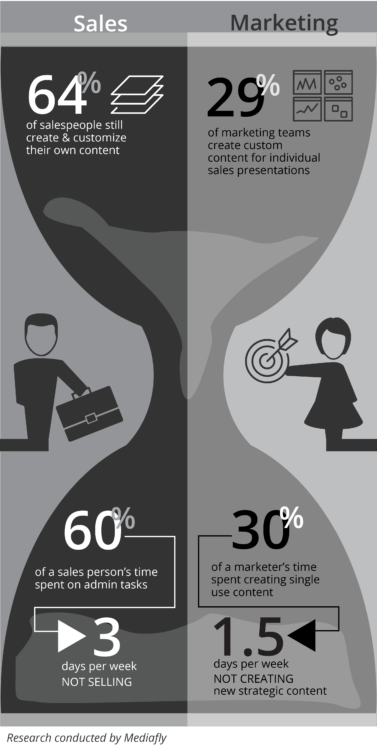We recently polled B2B sales and marketing leaders to better understand how their organizations are creating and distributing content and were shocked to learn that a whopping 64% of their salespeople still create and customize their own content. On top of that, 29% of their marketing teams are creating custom content for individual sales presentations, which can monopolize up to 30% of a marketer’s time.

1. Dynamic content allows sellers to spend more time selling
According to CSO Insights, sales reps are only spending 36% of their time selling. This means over 60% of their time is spent on administrative tasks such as searching for content, creating new materials and assembling presentations. That 60% equates to three full days each week in which a seller is not selling.
Modularizing content enables sellers to hand-pick content that best suits each buyer’s journey. In this way, marketing can create stronger sales content that is dynamic. Sellers can easily adapt the story beforehand and then pivot on a dime in the meeting to meet the buyer’s needs. This enables the sellers to have all the content they need at their fingertips, and also allows them to customize materials quickly.

2. Dynamic content assures marketers all sales collateral is current and on-brand.
Dynamic content allows marketers to control the messaging and branding included in all sales materials. By specifying exactly what sellers can modify, marketers can rest assured knowing sellers have what they need and can adapt presentations seamlessly without using an outdated logo or off-brand messaging.
When sellers create their own content or “rogue content,” this becomes problematic not only for marketers but for sales leadership as well. It becomes very difficult to understand what is moving a buyer down the funnel and what messaging is resonating throughout the process. By providing the sales team with dynamic content that they can tweak to make their own, you’re negating the need for them to spend time on unapproved content.
3. Dynamic content closes the feedback loop between sales and marketing
As we mentioned, rogue content creates problems for both marketing and sales leadership. In order to build a high-performing sales team, it’s vital to know what’s working and replicate that success. Standardization is the key to measuring success, and dynamic content can help. 
By standardizing the sales process, marketing and sales leadership can pinpoint what content is being used, at what point in the sales process, and how prospects are responding to it. From here, marketers can focus on creating more of what’s working and spend less time on what is not producing results. Once sales leadership understands what it takes to engage B2B buyers, they can equip their sales team, lower performers, and future hires with the content needed to be successful.
Note that a successful dynamic content strategy requires a feedback loop between sales and marketing, as it will not work without measuring what, how, and when content is being used and the result of each interaction. By allowing marketing to create dynamic content, salespeople will find they have more time back in their days and will ultimately create stronger engagements with prospects by recognizing and addressing the needs of their buyers.

Comments are closed.